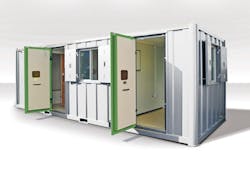NEATH, WEST GLAMORGAN, WALES – Groundhog is a 30-year-old manufacturer of standards-compliant welfare units in which staff working on construction projects can wash, change clothes, and eat. The company was one of the first to introduce these mobile facilities that avoid transportation and installation cost.
Production of mobile welfare units has doubled to 20 per week, while static units have risen from two to five per week. Highly productive machine tools, such as a laser cutter, are needed to support rapid increases in throughput, together with the use of automation where appropriate.
In June 2015, the company added a Bystronic 3kW BySprint 3015 fiber laser cutting machine equipped with a ByTrans 3015 12-shelf system for automated handling and storage of sheet metal. This machine took over from a Bystronic CO2 laser cutting machine with manual sheet loading and unloading that had been in use since 2006.
"The combination of the manually loaded CO2 laser cutter and our automated punch press, even with the latter running lights-out, could not cope with the doubling of production volumes," commented Matthew Stevenson, design manager at Groundhog. "There is not enough space in our current factory for two laser machines, so we decided to replace the CO2 model with the Bystronic fiber laser. This machine is equipped with the manufacturer's automation system, which actually takes up less space than the previous laser machine's manual loading area.
"Not only does the cell operate 24 hours a day, unmanned after our 8:00-4:30 day shift, but it also laser-cuts 1.5mm-thick mild steel sheet three times faster, with greater consistency, than our old same-power CO2 laser.
"We are now cutting at 18 rather than 6m per minute, profiling the sides, roof, doors, and other parts of our products. Combining high processing speed with low idle times for sheet exchange has dramatically raised the throughput of our welfare unit components."
Stevenson cited other advantages of fiber laser cutting over CO2 technology. Significantly lower power consumption saves running costs, no expensive consumable gases are needed, and maintenance is simpler, providing further economies.
Quality of cut is also better. Dimensional accuracy is within ±0.05mm, ensuring trouble-free bending and assembly of products. Additionally, no burrs are left on the material surface, eliminating the need to fettle components by hand, which can spoil their appearance.
While there is a three-fold speed advantage when cutting thinner materials—which is important, as 1.5mm gauge accounts for 60% of the 100 tons of steel processed per month—thicker metals can be cut efficiently as well. For example, steel up to 15mm thick has been through the fiber laser system, as have 8mm 310 stainless steel and 10mm aluminum.
Stevenson explained that this thickness of aluminum is five times greater than a CO2 laser is able to cut and the quality of the fiber laser-cut edge is markedly superior. Previously, thicker reflective materials were guillotined onsite if straight edges were needed or sent out to a water jet cutting specialist for profiling—at extra expense.
